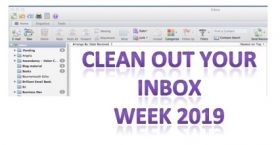Time is the scarcest resource and unless it is managed, nothing else can be managed. Peter Drucker

Clean Out Your Inbox Week 2019
Clean Out Your Inbox Inbox week 2019 is here. Why join in? Business email overload is still one executive’s main concerns according to recent surveys. They worry about cleaning out their inboxes and will stay up until 10.00pm clearing the backlog only to find their inbox full again in the morning. All this leads to increased stress and potential mental health problems. Sounds familiar? Join the club. This is why we have been running the International Clean Out Your Inbox Inbox week for over a decade to help you improve performance and creativity whilst reducing the stress and mental health issues arising from business email overload.
During Clean Out Your Inbox week we will share tips and hints on how to clean out your inbox, help other also clean out their inbox and then change people’s email behaviour to reduce business email overload long term.
It doesn’t matter what your role is in the organisation, PA, EA, CEO, Sales Director, etc., business email overload will be impacting you and your colleagues and can mean time wasted, an important email is overlooked, an email is sent in haste and causes the next email media disaster, an email is open quickly and initiates a cyber attack.
So lets get started aiming for a clean inbox by Friday.
Calibrate how clean is your inbox. Use our Cost of BusinessEmail Overload Calculator and dare to share the results as above.
Share your Clean Out Your Inbox week SMART goals and plans (see above). There are two a prizes for the best sets (copy of ‘Brilliant Email‘ and for PAs and EAs ‘Taking Control of Your Inbox‘).
Each day we will post the Clean Inbox week action for that day. Meanwhile ..
![]() Follow me on Twitter using #cleaninbox.
Follow me on Twitter using #cleaninbox.
![]() Join our Facebook page and Like us please.
Join our Facebook page and Like us please.
Tags: Brilliant Email, Business email overload, clean out your inbox week, cost of email overload, Mental Health and Email, Stress and email overload, Take Control of Your Inbox
 A constant problem associated with business email overload and hence information overload is picking out the important emails from all the dross. Deleting the less important ones often results in deleting those you really wanted, especially when using a mobile device. They key is to remember it is your inbox and no one (at least no email) should arrive without your permission.
A constant problem associated with business email overload and hence information overload is picking out the important emails from all the dross. Deleting the less important ones often results in deleting those you really wanted, especially when using a mobile device. They key is to remember it is your inbox and no one (at least no email) should arrive without your permission.
See the path to your inbox as an information highway along which emails travel but you and you alone decide which travel in the fast lane and arrive directly in your inbox and which travel in the slow lane via a width restrictor (folder).
Over the next week if you truly want to reduce your business email overload intake, do an inbox audit to benchmark your email intake using this simple five step exercise.
You must be absolutely ruthless otherwise at the end of the week you will still be suffering with business email and information overload and your inbox will remain heavily congested.
This blog is part of the series being written for IORG on whether or not business email overload will still be a problem in 2019.
Tags: Business email overload, Inbox audit, Reduce business email overload
I have no special talent. I am only passionately curious.
Einstein
After writing for over a decade about business email management to reduce business email overload it is sometimes hard to find material which adds anything new to what we know about how best to manage email to save time, improve well-being and performance. Often it’s the same tips and hints and studies just packaged differently. Over the last few weeks three have stood out.
1. Self promoting emails
Have you ever thought of using your Out-Of-Office message to promote yourself in your absence? For example, after telling the sender you are out of the office, then add a line about a recent success story, article about you, research paper etc. This is the latest trend being pushed by Harvard Business School to help you stand out in the ever crowded digital communications world. They suggest that research show that creating a positive view of yourself may help develop better more long standing network relationships. The jury is out on this one. Is it worthwhile or do such self-promoting emails actually have the reverse effect?
Do tell us what you think. Copy of Taking Control of Your Inbox for the best comments (for or against).
2.The state of email security?
In the last twelve month most organisations have seen a significant increase in email born cyber attacks and especially phishing attacks. This useful e-book (from Mimecast) highlights the status of email initiated cyber crime and provides advice on how to limit such attacks. Key is a robust training programme. This is something we, Mesmo Consultancy, would be pleased to talk to you about.
Meanwhile for some quick here and now tips to reduce the risk of cyber crime click here.
3.IORG Information Overload Day Webinar 2018
This year’s theme was cognitive science, addiction and information overload. One of the most interesting sessions was by Anne McGhee Stinson on ‘Neuroscience and Information Overload’. Specifically she talked about how our brain changes according to what we do and pay attention to. Her session is about 12 minutes in. Towards the end there is also a panel session which includes Dr Seeley on dealing with email addiction. Again if this is an issue for you or your colleagues why not call us to discuss how we have been helping other organisations. Click here for a quick check on your own personal level of email addiciton.
Tags: Business email management, Business email overload, Email Addiciton, Email born cyber crime, email cyber crime, email security, IORG
After writing about business email overload for the past decade, it still amazes me to hear executives complain about receiving over 70 emails a day but still having done nothing to identify why and what can be done to reduce email overload. This includes the whole spectrum of employees from CEOs to PAs.
Should I be surprised? After all many have suggested that email is nearing the end of its life and will be overtaken by collaborative tools and social media. Yet the data from Radicati suggests otherwise with email volumes set to rise by 4% in 2019.
Business email overload is generally a symptom of a wider personal, team or organisational failing. For example, lack of ability to focus on the task in hand, prioritise, insufficient opportunities to talk to one’s boss so instead we email, a need to cover one’s backside, no clear e-communications guidelines as to what to use when and so it goes on.
These are some of the more common underlying causes of business email overload which I have observed over the last decade. There are several easy ways to reduce the time spent dealing with unnecessary emails and these include:
As I take over the Social Media Chair for IORG for November (from my colleague Alfonso Aranda Arias), these are some of the issues I will address in a series of Blogs and Tweets.
Tags: Business email overload, email overload, IORG, Radicati Group
Most of us suffer from chronic business email overload. The new 2018 Adobe Email Research revealed that the most irritating email phrases include:
There is little doubt that these are words which make the blood pressure rise and can destroy good relationships. The question is why does it happen?
Mesmo Consultancy’s research indicates that we receive roughly one new email every five to seven minutes of which over 50% are deemed unnecessary by the receiver. After a one hour meeting about 12 new emails are now on top of the existing backlog. If like many you spend at least two hours a day in meetings that’s 24 new emails added to the already bulging inbox. Little wonder business email overload is a cause of high blood pressure and sleepless nights. It’s not uncommon to see 500+ unread emails in the inbox.
Whose fault is it that emails are not answered and what can be done to reduce the need for these highly irritating email follow-up? Does every email sent add business value or instead flatter the sender’s personal ego? Are we so disorganised and have such a high degree of email overload that it’s impossible to see the wood from the trees?
Sender’s perspective
There are a number of reasons why your email has may have been overlooked. Many related to common sense business email etiquette. Here are the top five we see most often and tips to overcome them to save time to reduce business email overload and hence improve business performance.
1. Email is too long. You are time poor and wrote the sentences as they came into your head. You didn’t have to re-read and revise it.
Tip #1 – Use the 5S Principle of Business Email Etiquette for writing good emails – keep it structured, short, succinct, spell-checked and simple formatting. If appropriate start with a one line executive summary.
2. No clear indication of what action is expected. Did you use the correct protocol for To and Cc and make it clear in the subject-line if any action is expected and by when?
Tip #2 – Always put the recipient in the To box if you expect action. Use the subject-line to be explicit if there is a deadline for action.
3. Sent well outside normal office hours. Now it is buried in the pile of other unread emails .
Tip #3 – Draft outside office hours but only send within normal office hours.
4. Wrong medium for the message. Oh dear we are so addicted to email that we forget there are other ways to communicate and especially if the message is urgent.
Tip #4 – Pick the right medium for your message, for example if it’s urgent phone/text message/walk and talk. Look outside the inbox for discussions, for example using a collaborative platform, conference call etc.
5. Love the sound of your own voice. In the days of silent open plan offices the easiest way to chat is by email. Some people just like to look busy by emailing.
Tip #5 – Take a look at your inner self and ask why you are sending the email, what purpose is it serving? To satisfy your own ego or add real business value?
Receiver’s perspective
Why did you ignore that email? Here are the top five reasons we see when coaching people to manage their email more efficiently
1. Email overload – too much email. You need to take control of what your receive and if needs be use filters to send less important emails directly to folders.
Tip #1 – Audit your inbox and reduce the number of emails you receive. Unsubscribe, use filters and remember it’s OK to say ‘No thank you’ to colleagues when included in a circulation list.
2. No adequate way to spot quickly emails from key contacts. With an average of 60 plus new emails a day, how do you spot those from important contacts and ensure they are dealt with?
Tip #2 – Implement a way of flagging/highlighting incoming emails from key contacts.
3. Email is too long and unclear what is expected. It really is not your fault if the sender rambles on, asks too many questions in one email etc.
Tip #3 – Push back. Don’t ignore the email hoping it will go away. Instead be bold and ask what is required and if needs be prioritise.
4. Too little time to check emails properly. We are all time poor and you need to prioritise your day.
Tip #4 – Make a meeting with yourself every day dedicated to dealing properly with your inbox instead of just surfing and skimming the content.
5. Easily distracted by new emails. You have a batch from yesterday, the meeting you have just attended and ping, you are distracted every five minutes as yet another new email arrives. Little wonder you probably have 500+ emails in your inbox.
Tip #5 – Turn off all those new email alerts. If needs be set one only for emails from the boss!
Whose Really At Fault
Over arching all these is the question of priorities and an organisational culture cover my backside culture. Given these different pressure points between the sender’s and the receiver’s perspective it is little wonder that emails go unanswered. Neither party is to blame, it is a combination of mismatches in personalities, styles and priorities. Hopefully these tips will help reduce the email overload caused by those annoying and irritating email follow-ups.
Can we Help You and Your Organisation?
For more ways to improve performance through more effective email management why not come on one of Mesmo Consultancy’s Smart Email Management masterclasses or workshop
Tags: 5S Principle of Business Email Etiquette, Adobe, business email etiquette, Business email overload, Business Performance, Irritating Emails, Mesmo Consultancy, Spell Check, To versus Cc, well being